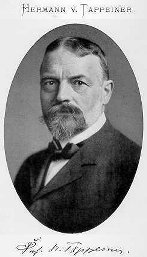Photosensitization - What Stopped the Wiggling?
Dennis P. Valenzeno
Associate Dean for Medical Sciences
Chair and Professor of the Department of Medical Sciences
The University of Kansas Medical Center - Wichita
1010 N. Kansas St., Wichita, KS 67214-3199
dvalenzeno@kumc.edu
(Reprinted from an article in the ASP Newsletter No. 127, Jun/Jul 1990)
"I don't understand it Dr. von Tappeiner, the paramecia were all wiggling just fine a minute ago, but now these over by the window seem to be dead."
The origin of photosensitization as a science is usually attributed to the work of Oscar Raab at the turn of the century. Although there are several accounts of photosensitization reactions in the writings of the Egyptians, Indians and Chinese dating to at least 30 centuries ago, the modern era is conveninetly recognized to begin in the year 1900.
Oscar Raab was a student of Hermann von Tappeiner. Raab was involved in a study of the toxicity of acridine towards paramecia. As is frequently the case in the research lab, Raab found that his results were quite variable. In this case, however, he was sufficiently observant and systematic to recognize that the apparent toxicity which he measured depended on the time of day when he performed his experiment. Near midday the toxicity was greatest. Raab realized that one of the variables in his work was the amount of light in the laboratory, and he subsequently demonstrated that paramecia in acridine solutions were inactivated more effectively if the solutions were kept near a bright window, than if they were kept in the dark.

Figure 1. Hermann von Tappeiner, mentor of Oscar Raab. [Courtesy of the Clendening History of Medicine Library, University of Kansas Medical Center.]
Two full publications on this work appeared in the year 1900. Raab's full account of his work as a medical student at the Pharmacological Institute of Munich demonstrated the light dependence and the requirement that the light be of wavelengths that were absorbed by the sensitizing "dye" (Raab, 1900). Von Tappeiner eventually originated the term "photodynamic" to refer to this photosensitization which was different from that seen in photographic plates. Von Tappeiner also published a short note on Raab's work on the second day of the year 1900, before Raab's report (von Tappeiner, 1900). This brief report, likely influenced by Finsen's work on the therapeutic potential of light itself, is of note today since it provided one of the first indications that photosensitization might prove to be of therapeutic benefit in areas such as dermatology.
References:
Raab, O. (1900) Z. Biol. 39, 524.
von Tappeiner, H. and O. Raab (1900) Munch. Med. Wochenschr. 47, 5.
Suggested Reading:
Spikes, J.D. (1985) The Historical Development of Ideas on Applications of Photosensitized Reactions in the Health Sciences. in Primary Processes in Biology and Medicine. Bensasson, R.V., G. Jori, E.J. Land and T.G. Truscott, eds. Plenum Press, NY.
Blum, Harold. (1941) Photodynamic Action and Diseases Caused by Light. Reinhold Publishing Corporation, NY.